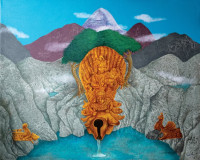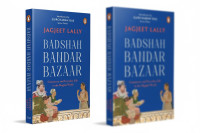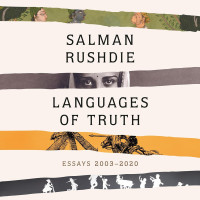Books
A modern retelling of the Ramayana
In ‘The Forest of Enchantments’, Chitra Banerjee Divakaruni humanises Sita but does little to show her as an empowered woman capable of choosing her fate.
Sanskriti Pokharel
It’s rare for a book cover to catch my attention. However, a few weeks ago, something unusual happened—a book cover sparked my curiosity.
The saying “Do not judge a book by its cover” seemed irrelevant. I found myself lured to pick up ‘The Forest of Enchantments’, written by Indian-American writer Chitra Banerjee Divakaruni, from my college library.
In this book, Divakaruni retells the mythological story of Ramayana.
We grew up listening to the story of the Ramayana in our childhood. Lord Ram’s valorousness, loyalty, compassion, and victories are well known.
The battles he won and his practice of righteousness have been widely read and acclaimed through generations.
Yet, another crucial figure in the Ramayana, the epitome of devotion and the silent pillar of strength, Devi Sita, is often overshadowed in literature making her voice unheard and unrecognised.
What sets ‘The Forest of Enchantments’ apart from other mythological fiction is that the author has narrated it through the voice of Sita, making her the story's protagonist.
Through a first-person point of view, Divakaruni sheds light on Sita’s life by retelling the adventures undertaken by the male characters, making readers feel like Sita is narrating her tale.
The book begins by providing glimpses of Sita’s life in the palace of Janak, where she ponders the mystery of her birth and her mother’s apprehension that Sita’s birth was ‘supernatural’.
The author emphasises how Sita developed a beautiful and almost surreal relationship with nature in and around the palace, highlighting her deep connection with plants and her healing touch.
The narration is beautifully woven with the threads of significant events surrounding Sita’s life, including her celestial marriage to Ram, her abduction by Ravana, her second exile and refuge in Valmiki’s hermitage during her pregnancy period, and her final act of self-respect when Sita stands up against the unjust action of proving her purity amongst the crowd of Aodhya by going back to her abode.
Through the conversation between Sita and her mother in chapter two, the book questions the patriarchal beliefs that only a man should be the ruler of a country.
“The kingdom of Mithila can be ruled only by a man. This has been the country's custom since before the scribes began to write its history.”
“Why can’t customs change?” I asked angrily. Especially ones that don’t make sense?”
The author has portrayed Sita’s journey from childhood to womanhood, presenting her in a way that resonates deeply with every woman.
Sita, though divine, is laminated with such human-like characteristics that her traits become universally relatable.
Through Banerjee's vivid characterisation, readers witness Sita's desires, emotions, and urges, alongside her stubbornness, anger, determination, and occasional clinginess.
These qualities reflect our behaviours and emotional fluctuations. While embodying the sacredness in her, Divakaruni has mirrored the ordinary facets of our lives, making her story profoundly moving and relatable.
Not to mention, the author has done a praiseworthy job of shedding light not only on Sita but also on the unsung female heroes of the Ramayana, such as her dear sisters Urmila and Mandavi, her mother and mother-in-law, Surpanakha and Mandodari.
Through Sita’s interactions with them, readers get a glimpse of the unheard roles of these strong, unsung female figures who were often trivialised and deemed voiceless in literature. Their representation reflects the place of women in society centuries ago.
As the story unfolded, the portrayal of Ram assured me that he is not as stoic and self-assured as I have read about him in other fictional books.
His conversations with Sita reflect his vulnerabilities, fears, and insecurities.
The way he opens his sealed heart to Sita at bedtime, sharing his childhood woes and plans and receiving her consolation and encouragement, illustrates a break from stereotypical male and female roles.
This humanises Ram, making the venerated God relatable.
The book also emphasises the nature of Sita and Ram’s relationship. Divakaruni highlights how bedtime became a secret gift Sita looked forward to all day while they were engaged with their separate duties during the day.
Divakaruni writes, “Ram was not shy about telling me what pleased him, and he asked me what I liked until I overcame my shyness and answered.”
The line reflects their communicative relationship. Most importantly, it sheds light on the often disdained and trivialised aspect of sexual intimacy in mythological fiction.
While the book provides a modern interpretation of the Ramayana, it adheres too closely to the traditional sources, limiting opportunities for new and innovative reinterpretations.
Sita questions the patriarchy and subjugation of minorities, but she ends up withholding her answers.
Although the book ends with Sita refusing to undergo agni parikshya to prove her chastity to satisfy the Ayodhya people, it does not do justice to her as an independent woman.
From her childhood until her old age, the author has portrayed a life that vehemently revolves around men, such as her father, husband, and later her sons.
This made me feel like Sita did not live for herself. Divakaruni could have focused more on demonstrating how Sita, finding joy in little things, has also lived her life for herself.
Overall, the book significantly contributes to the mythological retelling genre.
Divakaruni succeeded in crafting a powerful portrait of Sita, allowing readers to view her as a protagonist with her strengths and weaknesses.
The Forest of Enchantments
Author: Chitra Banerjee Divakaruni
Year: 2019
Publisher: HarperCollins India
Pages: 361




 15.12°C Kathmandu
15.12°C Kathmandu











